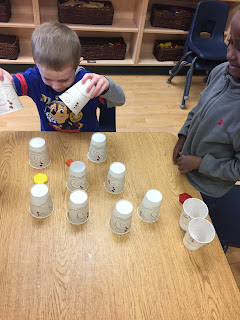Home » Small Group Instruction: Time to Practice and Play
Posted by:
Categories
Date
Traditionally small group learning takes place with a group of 3-5 students and an educator. Often times the small group is focused on a very specific academic based skill and takes place at a table in the classroom.
Sometimes, it is the things that “don’t work” that teach you how to develop a system that “does work” in the classroom. We are constantly revising and rethinking the way that we do things in our classroom. Everyday we have discussions about how things are going and how we can make minor adjustments.
We decided to slightly restructure our small group instruction (both the time and structure of the groups). We wanted to ensure that children had long, uninterrupted blocks of play both inside and outdoors. We wanted to ensure that we were reflecting carefully on what was happening in the small group time. And most importantly, we wanted to think creatively about the skills we were supporting, scaffolding, teaching, and reinforcing during small group experiences.

Students used the number line to support them in reading the numerals on the dice in the game Frustration. This was such a powerful example of peer teaching – another student noticed that their peer was struggling with number recognition and supported them by teaching a tool that they found helpful.

Many of our students practice skills such as Coding during Small Group Learning Time.

Simple Matching Games: Using cups, you can place different objects underneath to create a matching game.
OSMO is another great app that supports spatial awareness and reasoning, geometry, communication, and team work.
When having a conversation with a colleague, they made a really interesting connection between play and the skills that developmentally are important for children to learn.
When learning to play the piano, one can simply sit down and “play”. You can try out different combinations with the keys, you may learn simple songs by experimenting, you can enjoy the music that is created.
However, in order to learn how to play the piano one needs to learn some basic skills (e.g., how to hold or position your hands, how to put notes together, how to read music etc).
We have found that some of those beginning skills such as writing your name can be fostered in the context of play, however, when practiced for a short period of time the skill becomes automatic, more comfortable, and confidence develops.
We have noticed that our small group learning experiences are providing the students with short, structured times to practice the things that THEY NEED. They are then bringing those new skills into the context of their play. This is the beauty of transference. It is almost magical to see these fundaments come into their play in context!
This year, more than any other year, we have seen our students really excited for small group learning time. They are developing resilience, new skills, and stamina. They know that they won’t be taken out of their play to practice these skills and perhaps that is why we have seen very little resistance and a high interest in this focused time of the day.
Puzzles are something that students have really been drawn to this year. We have increasingly invited students to try harder puzzles as the year has progressed. Our small group planning allows us to choose which students need to practice which type/difficulty of puzzle.
Incorporating sensory into small groups has been important and valuable for our students. Play dough, sand and water with tools and materials that are DIFFERENT than those used during learning centres.

Sometimes, simple is best. Some students who are just understanding and recognizing numerals worked as a team to sort a basket of numbers using playing cards and our number line.

Whiteboards and Different Writing Opportunities: We often have a small group that focuses on writing opportunities. Some students are working on just lines and curves (perhaps holding a writing tool), some are practicing their name, some enjoy drawing or writing the names of their peers.
Where does this fit into the Flow of the Day? Check out our Fall Blog Post.
Sign up for our mailing list if you would like to stay connected, learn about new ideas that can be implemented in your classroom, get access to exclusive material and offers.
We respect your privacy.
Copyright 2019 – PCE Connecting Learners. | Designed & Developed by BrandCo House.
